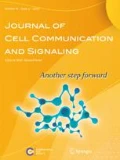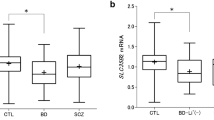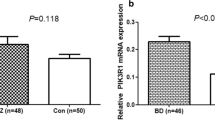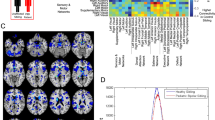Abstract
The involvement of phosphoinositides (PI) signal transduction pathway and related molecules, such as the Phosphoinositide-specific Phospholipase C (PI-PLC) enzymes, in the pathophysiology of mood disorders is corroborated by a number of recent evidences. Our previous works identified the deletion of PLCB1 gene, which codifies for the PI-PLC β1 enzyme, in 4 out 15 patients affected with schizophrenia, and no deletion both in major depression affected patients and in normal controls. By using interphase fluorescent in situ hybridization methodology, we analyzed PLCB1 in paraffin embedded samples of orbito-frontal cortex of 15 patients affected with bipolar disorder. Deletion of PLCB1 was identified in one female patient.

Similar content being viewed by others
Abbreviations
- SSC:
-
Saline-sodium citrate buffer
- DAPI:
-
4',6-diamino-2-phenylindole dihydrochloride
References
Berridge MJ, Irvine RF (1984) Inositol triphosphate, a novel second messenger in cellular signal transduction. Nature 312:315–321
Bunney TD, Katan M (2011) PLC regulation: emerging pictures for molecular mechanisms. Trends Biochem Sci 36(2):88–96
Choi WC, Gerfen CR, Suh PG, Rhee SG (1989) Immunohistochemical localization of a brain isozyme of phospholipase C (PLC III) in astroglia in rat brain. Brain Res 499(1):193–197
Comer FI, Parent CA (2007) Phosphoinositides specify polarity during epithelial organ development. Cell 128(2):239–240
Ebstein RP, Lerer B, Bennett ER, Shapira B, Kindler S, Shemesh Z, Gerstenhaber N (1988) Lithium modulation of second messenger signal amplification in man: inhibition of phosphatidylinositol-specific phospholipase C and adenylate cyclase activity. Psychiatry Res 24(1):45–52
Fanous AH, Neale MC, Webb BT, Straub RE, O’Neill FA, Walsh D, Riley BP, Kendler KS (2008) Novel linkage to chromosome 20p using latent classes of psychotic illness in 270 Irish high-density families. Biol Psychiatry 64(2):121–127
Hannan AJ, Kind PC, Blakemore C (1998) Phospholipase C-beta1 expression correlates with neuronal differentiation and synaptic plasticity in rat somatosensory cortex. Neuropharmacology 37:593–605
Hokin MR, Hokin LE (1953) Enzyme secretion and the incorporation of P32 into phospholipides of pancreas slices. J Biol Chem 203(2):967–977
Hovatta I, Lichtermann D, Juvonen H, Suvisaari J, Terwilliger JD, Arajärvi R, Kokko-Sahin ML, Ekelund J, Lönnqvist J, Peltonen L (1998) Linkage analysis of putative schizophrenia gene candidate regions on chromosomes 3p, 5q, 6p, 8p, 20p and 22q in a population-based sampled Finnish family set. Mol Psychiat 3(5):452–457
Jope RS, Song L, Li PP, Young LT, Kish SJ, Pacheco MA, Warsh JJ (1996) The phosphoinositide signal transduction system is impaired in bipolar affective disorder brain. J Neurochem 66(6):2402–2409
Kim D, Jun KS, Lee SB, Kang NG, Min DS, Kim YH, Ryu SH, Suh PG, Shin HS (1997) Phospholipase C isozymes selectively couple to specific neurotransmitter receptors. Nature 389:290–293
Kurian MA, Meyer E, Vassallo G, Morgan NV, Prakash N, Pasha S, Hai NA, Shuib S, Rahman F, Wassmer E, Cross JH, O’Callaghan FJ, Osborne PJ, Scheffer IE, Gissen P, Maher ER (2010) Phospholipase C beta 1 deficiency is ass Sociated with early-onset epileptic encephalopathy. Brain 133:2964–2970
Lengauer C, Riethman H, Cremer T (1990) Painting of human chromosomes with probes generated from hybrid cell lines by PCR with Alu and L1 primers. Hum Genet 86(1):1–6
Lo Vasco VR. The Phosphoinositide pathway and the signal transduction network in neural development. Neuroscience Bulletin (accepted on 7th, May 2012)
Lo Vasco VR, Polonia P (2012) Molecular cytogenetic interphase analysis of Phosphoinositide-specific Phospholipase C β1 gene in paraffin-embedded brain samples of major depression patients. J Affect Disord 136(1–2):177–180
Lo Vasco VR, Fabrizi C, Artico M, Cocco L, Billi AM, Fumagalli L, Manzoli FA (2007) Expression of phosphoinositide-specific phospholipase C isoenzymes in cultured astrocytes. J Cell Biochem 100:952–959
Lo Vasco VR, Fabrizi C, Fumagalli L, Cocco L (2010) Expression of phosphoinositide specific phospholipase C isoenzymes in cultured astrocytes activated after stimulation with Lipopolysaccharide. J Cell Biochem 109(5):1006–1012
Lo Vasco VR, Cardinale G, Polonia P (2012) Deletion of PLCB1 gene in schizophrenia affected patients. J Cell Mol Med 16(4):844–851
McOmish CE, Burrows EL, Howard M, Hannan AJ (2008) PLC-b1 Knockout Mice as a Model of Disrupted Cortical Development and Plasticity: Behavioral Endophenotypes and Dysregulation of RGS4 Gene Expression. Hippocampus 18(8):824–834
Noh DY, Shin SH, Rhee SG (1995) Phosphoinositide-specific phospholipase C and mitogenic signalling. Biochim Biophys Acta 1242:99–114
Pacheco MA, Jope RS (1996) Phosphoinositide signaling in human brain. Prog Neurobiol 50(2–3):255–273
Peruzzi D, Calabrese G, Faenza I, Manzoli L, Matteucci A, Gianfrancesco F, Billi AM, Stuppia L, Palka G, Cocco L (2000) Identification and chromosomal localisation by fluorescence in situ hybridisation of human gene of phosphoinositide-specific phospholipase Cb1. Biochim Biophys Acta 484:175–182
Ross CA, MacCumber MW, Glatt CE, Snyder SH (1989) Brain phospholipase C isozymes: differential mRNA localizations by in situ hybridization. Proc Natl Acad Sci U S A 86:2923–2927
Spires TL, Molnar Z, Kind PC, Cordery PM, Upton AL, Blakemore C, Hannan AJ (2005) Activity-dependent regulation of synapse and dendritic spine morphology in developing barrel cortex requires phospholipase C-beta1 signalling. Cereb Cortex 15:385–393
Suh PG, Park J, Manzoli L, Cocco L, Peak JC, Katan M, Fukami K, Kataoka T, Yuk S, Ryu SH (2008) Multiple roles of phosphoinositide-specific phospholipase C isozymes. BMB Reports 41:415–434
Tanis KQ, Duman RS (2007) Intracellular signaling pathways pave roads to recovery for mood disorders. Ann Med 39(7):531–544
Udawela M, Scarr E, Hannan AJ, Thomas EA, Dean B (2011) Phospholipase C beta 1 expression in the dorsolateral prefrontal cortex from patients with schizophrenia at different stages of illness. Aust N Z J Psychiatry 45(2):140–147
van Dekken H, Pizzolo JG, Reuter VE, Melamed MR (1990) Cytogenetic analysis of human solid tumors by in situ hybridization with a set of 12 chromosome-specific DNA probes. Cytogenet Cell Genet 54(3–4):103–107
Wallace MA, Claro E (1990) A novel role for dopamine: inhibition of muscarinic cholinergic-stimulated phosphoinositide hydrolysis in rat brain cortical membranes. Neurosci Lett 110:155–161
Author information
Authors and Affiliations
Corresponding author
Additional information
Submission declarations
The Corresponding Author, Dr Vincenza Rita Lo Vasco, has the right to grant on behalf of all authors and does grant on behalf of all authors, an exclusive licence (or non exclusive for government employees) on a worldwide basis to permit this article (if accepted) to be published in this journal.
The Authors disclose any commercial associations that might pose a conflict of interest in connection with the submitted manuscript and indicates that there are no conflicts.
The AUTHORS, Dr Vincenza Rita Lo Vasco and Dr Patrizia Polonia, declare that:
the submitted work has not been published previously, it is not under consideration for publication elsewhere, its publication is approved by all authors and tacitly or explicitly by the responsible authorities where the work was carried out, and, if accepted, it will not be published elsewhere including electronically in the same form, in English or in any other language, without the written consent of the copyright-holder.
Author contribution
The authors materially participated in the research and/or article preparation. Vincenza Rita Lo Vasco: participated in concept and design of the research; carrying out the experimental work; data analysis and interpretation; writing of the article. Patrizia Polonia and Lucia Longo: participated in data analysis and interpretation; writing of the article.
Rights and permissions
About this article
Cite this article
Lo Vasco, V.R., Longo, L. & Polonia, P. Phosphoinositide-specific Phospholipase C β1 gene deletion in bipolar disorder affected patient. J. Cell Commun. Signal. 7, 25–29 (2013). https://doi.org/10.1007/s12079-012-0182-2
Received:
Accepted:
Published:
Issue Date:
DOI: https://doi.org/10.1007/s12079-012-0182-2




